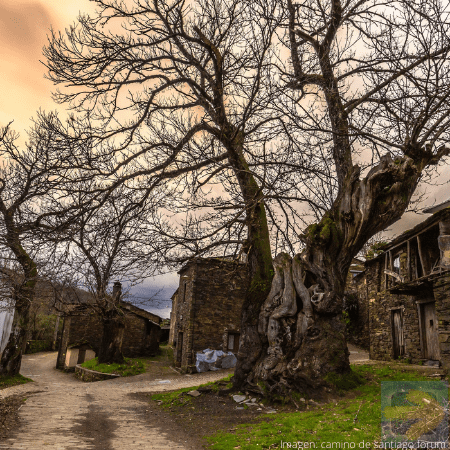THE CHESTNUT TREE.

It’s been on the Camino de Santiago for over 800 years. Its impressive structure appears to be a weather map. And no pilgrim goes back home without taking a picture with it. Have you already guessed what it is? We are talking about one of the natural jewels on the Camino Francés or French Way: the centennial chestnut tree of Ramil. An outstanding tree welcoming pilgrims upon their arrival at Triacastela, inviting us to think about the Jacobean Routes’ rich heritage.
When Aymeric Picaud, author of the notorious Codex Calixtinus, walked the Camino de Santiago, Ramil’s chestnut tree was already there. Back then, the young tree probably did not stand out much to the monk. But now, after eight centuries, no one can remain indifferent in front of such grandeur and beauty.
It’s a tree with almost 850 years of life, according to data provided by the Superior School of Rural Engineering of Madrid. Over eight centuries that are reflected in its almost nine meters in perimeter, its impossible gaps and thick branches. Its location is perfect. Barely 1 kilometer away from the entrance to Triacastela, this natural jewel welcomes pilgrims, making them forget about the hard climb up to O Cebreiro and the over 100 kilometers left to get to Santiago de Compostela.
Everyone falls in love with this chestnut tree. No pilgrim can resist the temptation to stop and take a picture with the tree. Not only those who walk but also those who are doing the Camino de Santiago by bike or even horseback riding. Such is the frequency that it seems that, except for the Eiffel Tower in Paris, there are few things as photographed as this chestnut tree. That is why it has earned the title of the tree of the Camino de Santiago.
This centennial tree is, without a doubt, one of Triacastela’s biggest attractions. But not the only one. This small village located in the province of Lugo is a historic Jacobean place, already included in the Codex Calixtinus. Aymeric Picaud references the origin of its name there: three castles, probably Celtic castles or forts, that used to surround the city and of which some remains are still preserved. Besides its crest, this historic reference can be seen in its Romanesque church, dedicated to Saint James the Apostle, of course.
Also, a significant amount of the materials used to build the Cathedral of Santiago came from Triacastela. So the tradition says, according to which pilgrims took a piece of lime from this land and took it to Castañeda and Arzúa, where it was melted to be transported to Compostela and used for building the temple.
Is it not this place and tree a real jewel of the Camino de Santiago?
An article by elcaminoconcorreos.
And remember, whatever path you may choose in the Camino, you can always rely on HOSTAL GAU TXORI: comfortable accommodation, nice and traditional food and a wonderful natural landscapes as you pass by Zubiri.


